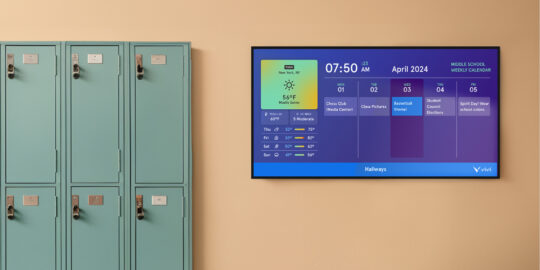
Most of us can picture our own school days clearly: rows of desks, the teacher at the front, reading from a textbook or writing out long equations on the chalkboard. We can probably remember passing a note or two or making endless doodles in the margins of our notebooks. Usually, our teachers did most of the talking.
It’s now 2024, and many educators are moving away from the “sage on the stage” model and instead focusing on ensuring their students are active participants in what they’re learning. By shifting from a teacher–centered mode of learning, students can take greater ownership and agency over the whole learning experience, offering new possibilities for students and teachers.
Student-centered learning gives students opportunities to take ownership and agency of their learning in a safe and supportive way. This means sharing their voice, creativity and mastery of content; all the while making choices around how, where, and what they’re learning. Technology plays a key part in making this vision a reality.
In a recent webinar, we invited several educators to share how they are leveraging Vivi to empower students and educators to engage more easily with both content and each other, allowing for quick and easy collaboration and no clunky tech getting in the way of the learning process. Here’s what they had to say:
Tip #1: Plan your classroom set-up around students
Instead of focusing students’ attention on the teacher’s desk at the front of the classroom, situate a Vivi and a document camera on a rolling cart – adding mobility and flexibility to any learning experience. Try arranging student desks into a circle or pods to help students work together and collaborate on instructional material. “Small changes can make a big difference” said Abby Pagryzinski, training and development specialist for Carmel Clay Schools in Indiana, “The first word that came into my mind is energy. I feel like when it’s student centered, it doesn’t have to be loud, necessarily. But you can just feel the buzz; you walk into the room, and everyone is engaged, everyone’s interacting or collaborating.”
Tip #2: When introducing new technology, set your teachers up for success with a Train the Trainer Model.
Though the myriad features of a new system and software can seem daunting, there is much to be said for a carefully thought-out training program, led by teachers, who then train the rest of their peers. Kari Moulton, technology integration support specialist at Bourbonnais Elementary School District in Illinois shared their approach: “We’ve taken the ‘train the trainer’ kind of model. We have teachers and tech leaders from K through eighth. Starting from the beginning of August, we picked three top Vivi strategies, like whiteboard assessment and giving student control. Then we train a handful of teachers on the strategies, and then we ask those folks to train the rest of the teachers. And we kind of break up to focus on one strategy at a time up until each school break. It’s a great way of reaching teachers who don’t always take instruction well from other people, but they appreciate learning from their peers. If we have their peers train them, then they know, okay, if I mess up, I have someone that’s right next door that can help me when I’m stuck.”
Tip #3: Use a phased approach to trying new strategies
Being thoughtful in the rollout of new systems and technologies is always a good idea. A phased approach allows for full mastery of each feature, resulting in more successful classroom usage and collaboration. Many schools opt to give teachers a broad overview, then use their own trainer tips and those provided by Vivi to share out further ideas throughout the school year, in staff meetings and during scheduled professional development (PD) time. This keeps teachers from being overwhelmed; instead, it helps teachers build their confidence over time.
Tip #4: Remove obstacles to student participation
Shifting the focus to a more student-centered approach to learning is beneficial in many ways. The old come-to-the-front-to-share approach was often an anxiety-inducing endeavor that then affected students’ confidence. Having all eyes on you can be scary! Vivi has flipped those negative feelings about sharing work by allowing students to share from wherever they are in the room. Similarly, allowing up to four students to share their work simultaneously to the classroom display using multiple screen share, creates safety in numbers. The result, a more comfortable and normalized sharing experience that helps learners feel seen.
Julie Patchen, a K-5 music educator at Elkhorn Public Schools in Nebraska expanded on this idea, “We have individual students share [their written music]. What this allows is that students don’t have to stand in front of the classroom to perform their composition; that they can sit, where they feel comfortable, and then share it with a class. They’re so excited to share [this way] rather than having to feel timid about standing in the front of the classroom and perform it, which then leads into conversations about how you can be a composer, but you don’t have to be the performer of the music you create. And so that takes that anxiety piece away.”
Creating positive energy in the classroom takes intention but doesn’t have to be difficult. Tools like Vivi make it simpler to let students take the lead.
For more tips, watch the full webinar on demand on your schedule.



